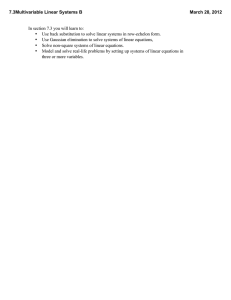Course 111: Algebra, 2nd Feb 2007
advertisement
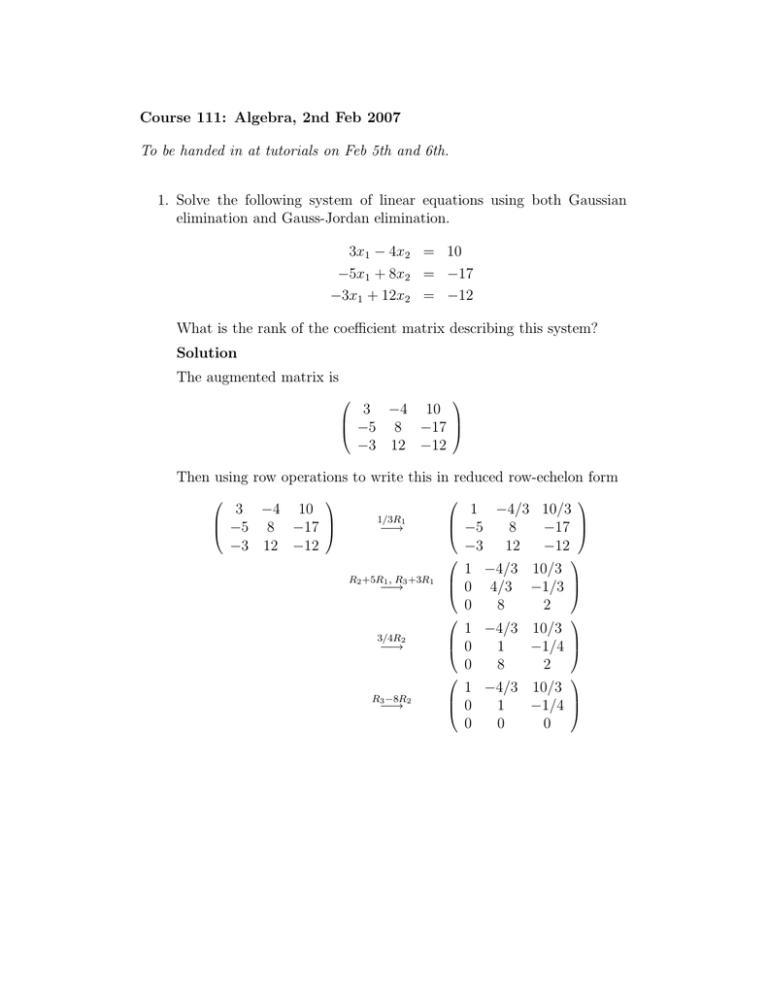
Course 111: Algebra, 2nd Feb 2007
To be handed in at tutorials on Feb 5th and 6th.
1. Solve the following system of linear equations using both Gaussian
elimination and Gauss-Jordan elimination.
3x1 − 4x2 = 10
−5x1 + 8x2 = −17
−3x1 + 12x2 = −12
What is the rank of the coefficient matrix describing this system?
Solution
The augmented matrix is
3 −4 10
−5 8 −17
−3 12 −12
Then using row operations to write this in reduced row-echelon form
3 −4 10
−5 8 −17
−3 12 −12
1/3R1
R2 +5R1 , R3 +3R1
3/4R2
R3 −8R2
−→
−→
−→
−→
1 −4/3 10/3
8
−17
−5
−3 12
−12
1 −4/3 10/3
0 4/3 −1/3
0
8
2
1 −4/3 10/3
1
−1/4
0
0
8
2
1 −4/3 10/3
1
−1/4
0
0
0
0
This is the matrix in row-echelon form. Writing this as equations to
solve by Gaussian elimination gives
4
10
10 4
x1 − x2 =
⇒ x1 =
+ x2
3
3
3
3
1
x2 = −
4
To continue to reduced row-echelon form we need an additional row
operation:
1 −4/3 10/3
1
−1/4
0
0
0
0
R1 +4/3R2
−→
1 0
3
0 1 −1/4
0 0
0
This is the reduced row-echelon form and now writing this as equations
we have immediately that
x1 = 3
x2 = −
Agreeing with the solutions above.
Rank is 2
1
4
2. Solve the following system of linear equations using both Gaussian
elimination and Gauss-Jordan elimination.
7x1 + 2x2 − 2x3 − 4x4 + 3x5 = 8
−3x1 − 3x2 + 2x4 + x5 = −1
4x1 − x2 − 8x3 + 20x5 = 1
What is the rank of the coefficient matrix describing this system?
Solution
The augmented matrix is
7
2 −2 −4 3 8
2 1 −1
−3 −3 0
4 −1 −8 0 20 1
Then using row operations to write this in reduced row-echelon form
7
2 −2 −4 3 8
2 1 −1
−3 −3 0
4 −1 8
0 20 1
R1 +2R2
R2 +3R1 , R3 −4R1
R2 ↔R3
R3 +R2
1
R ,− 61 R3
15 2
−→
−→
−→
−→
−→
1 −4 −2 0 5 6
−3 −3 0 2 1 −1
4 −1 −8 0 20 1
1 −4 −2 0 5
6
0 −15 −6 2 16 17
0 15
0 0 0 −23
1 −4 −2 0 5
6
0 0 0 −23
0 15
0 −15 −6 2 16 17
1 −4 −2 0 5
6
0
15
0
0
0
−23
0 0 −6 2 16 −6
1 −4 −2
0
5
6
0
0
0
−23/15
0 1
0 0
1 −1/3 −8/3
1
This is row-echelon form. You then need to solve:
1
8
x3 − x4 − x5 = 1
3
3
x2 = −
x1 − 4x2 − 2x3 + 5x5 = 6
23
15
and you see that this can’t be solved uniquely for x1 , x2 , x3 , x4 and
x5 . Reducing the matrix still further to RREF using Gauss-Jordan
Elimination should give the same result ...
1 −4 −2
0
5
6
0
0
0
−23/15
0 1
0 0
1 −1/3 −8/3
1
R1 +2R3
R1 +4R2
−→
−→
2
1
28
28 2
1
x1 − x4 − x5 =
⇒ x1 =
+ x4 + x5
3
3
15
15 3
3
23
x2 = −
15
1
8
1
8
x3 − x4 − x5 = 1 ⇒ x 3 = 1 + x4 − x5
3
3
3
3
Writing the equations this way you see there are two free variables.
So, if we say x4 = t and x5 = s where s and t are any numbers then
we can solve up to s and t, giving,
1
28 2
+ t+ s
15 3
3
23
=
15
1
8
= 1+ t+ s
3
3
= t
= s
x2
x3
x4
x5
Rank is 3
1 0 0 −2/3 −1/3 28/15
0
0
−23/15
0 1 0
0 0 1 −1/3 −8/3
1
and this is reduced row-echelon form. Going back to write this as
equations we get
x1 =
1 −4 0 −2/3 −1/3
8
0
0
−23/15
0 1 0
0 0 1 −1/3 −8/3
1
3. Prove that if A is an n × n matrix (ie. A describes a system with as
many equations as unknowns) then the reduced row-echelon form of
the matrix will either contain at least one row of all zeroes or it will be
the n × n identity matrix, In where
1 ...
. .
I = .. . .
0 ...
0
..
.
{z
}
|
1
n cols, n rows
Proof:
Suppose B is the reduced row-echelon form of the matrix. If B has at
least one row of all zeroes then we are done.
Now suppose B does not have a row of all zeroes. This means that
every row has a leading 1 in it since it is in RREF.
The leading 1 of a row must be the right of the leading 1 of the row
immediately above it. Since B is a square matrix (n × n) and does not
have any rows of all zeroes we can figure out the position of each of the
leading 1’s in B.
First, suppose that the leading 1 in the first row is NOT b11 (i.e. b11 =
0). Then the next possible location of the leading 1 in the first row
would then be b12 . If this is where the leading 1 is then B must have
the following form.
B=
0
0
..
.
1 b13 . . . b1n
0 b23 . . . b2n
..
.. ..
.
. .
0 0 bn3 . . . bnn
Now, assume the leading 1 of each of the lower rows is exactly one
column to the right of the leading 1 above it. This however, leads us
to a contradiction. Because the first leading 1 is in the second column
by the time we reach the (n-1)st row the leading 1 will be in the nth
column and this will in turn force the nth row to be a row of all zeroes,
contradicting the initial assumption.
Similarly, if the leading 1 is placed to the right by say 2 columns (or 3
or 4, etc.) the same problem results but with more than one row of all
zeroes.
Likewise the leading 1 in the first row in any of b13 , b14 , . . . , b1n leads to
the same problem. So, to satisfy the assumption that we do not have
any rows of all zeroes we must have that the leading 1 in the first row
must be at b11 .
Using a similar argument we can see that if the leading 1 on any of
the lower rows moves to the right more than one column we will have
a leading 1 in the nth column prior to hitting the nth row. This in turn
forces at least the nth row to be a row of all zeroes contradicting the
initial assumption.
Therefore, the leading 1 in the first row is at b11 and the only way to
not have a row of all zeroes at the bottom is to have the leading 1’s of
a row be exactly one column to the right of the leading 1 of the row
above it. This means that the leading 1 in the second row must be at
b22 , the leading 1 in the third row must be at b33 , etc. And finally in
the nth row leading 1 must be at bnn .
Therefore the leading 1’s of B are on the diagonal and since B is in
reduced row-echelon form all the entries above and below the leading
1’s are zeroes. This is exactly In . Therefore, if B does not have a row
of all zeroes then we must have that B = In .
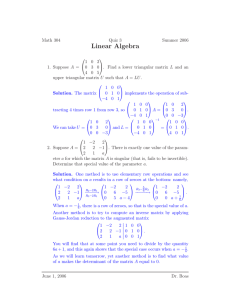
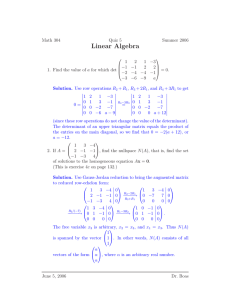
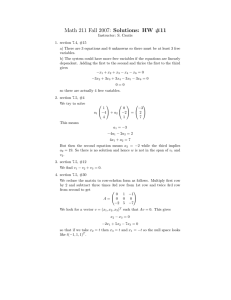
![Quiz #2 & Solutions Math 304 February 12, 2003 1. [10 points] Let](http://s2.studylib.net/store/data/010555391_1-eab6212264cdd44f54c9d1f524071fa5-300x300.png)

